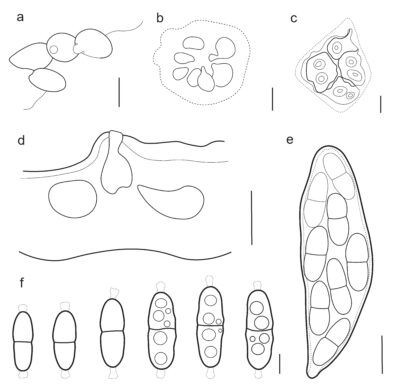Fungalpedia – Note 400, Alnecium
Alnecium Voglmayr & Jaklitsch
Citation when using this data: Tibpromma et al. 2024 (in prep.) – Fungalpedia, Ascomycota.
Index Fungorum, Facesoffungi, MycoBank, GenBank, Fig. 1
Classification: Incertae sedis, Diaporthales, Diaporthomycetidae, Sordariomycetes, Pezizomycotina, Ascomycota, Fungi
Alnecium was established as a monotypic genus within the Gnomoniaceae by Voglmayr and Jaklitsch (2014), with A. auctum designated as its type species. The classification of Alnecium auctum has varied across different genera over the years, indicating significant uncertainty regarding its generic affiliation (Voglmayr & Jaklitsch 2014). Historical classifications by Petrak (1923) and Barr (1978) placed Alnecium auctum within Prosthecium, whereas Wehmeyer (1941) associated it with Melanconis. Its phylogenetic assignment to Gnomoniaceae was unexpected, given that no prior mycologist has linked it to a genus considered part of this family. The Gnomoniaceae family predominantly comprises members that colonize non-woody materials, such as the leaves, culms, and stalks of herbaceous plants or the leaves of trees and shrubs. Only a few genera within the family inhabit the bark of trees, as highlighted by Voglmayr and Jaklitsch (2014). Alnecium species are distinguished as bark-inhabiting fungi on trees. Utilizing combined phylogenetic analysis of ITS, LSU, rpb2, and tef1 sequences through maximum parsimony and maximum likelihood methods, Voglmayr and Jaklitsch (2014) demonstrated that Alnecium auctum forms a sister clade to the Ditopella ditopa/Phragmoporthe conformed clade within the Gnomoniaceae. Alnecium shares certain features with the expanded concept of Plagiostoma, such as the configuration of ascomata in indistinct or reduced pseudostromatic tissues (Voglmayr & Jaklitsch 2014). However, the ascospores of Alnecium are thick-walled and turn brown with age, in contrast to the bark-inhabiting species Plagiostoma and Diaporthe, which have thin-walled, hyaline ascospores (Voglmayr & Jaklitsch 2014). Similarly, Amphiporthe ascospores are reminiscent of Diaporthe. Ditopella and Phragmoporthe, which also occur on Alnus, are differentiated from Alnecium by their lack of stroma, except for a rudimentary clypeus around ostioles, thin-walled ascospores, polysporous asci (in Ditopella), or hyaline phragmospores (in Phragmoporthe) (Voglmayr & Jaklitsch 2014). Alnecium is characterized by its ascomata, which are immersed in groups, black, with erumpent necks, and ellipsoid, 1-septate, thick-walled, hyaline ascospores that eventually become 3-septate and pale brown with age, featuring a gelatinous appendage at each end (Voglmayr & Jaklitsch 2014). To date, no additional monotypic species have been added to this genus.
Type species: Alnecium auctum (Berk. & Broome) Voglmayr & Jaklitsch
Other accepted species: This genus is monotypic.
Figure 1 – Alnecium auctum. a Ascomata on host. b Pseudostroma in transverse section, showing perithecia. c Scarcely erumpent ectostroma and compressed ostioles in surface view. d Pseudostroma in vertical section. e Asci. f Ascospores. Scale bars: a, c = 200 μm, b, d = 500 μm, g = 20 μm, f = 10 μm. Redrawn from Voglmayr and Jaklitsch (2014).
References
Barr ME. 1978 – The Diaporthales of North America. Mycological Memoirs 7, 1–232.
Petrak F. 1923 – Mykologische Notizen VI. Annales Mycologici 21: 182–335.
Entry by
Wanasinghe DN, Center for Mountain Futures, Kunming Institute of Botany, Chinese Academy of Sciences, Honghe 654400, China.
(Edited by Saowaluck Tibpromma, Samaneh Chaharmiri-Dokhaharani, & Achala R. Rathnayaka)
Published online 26 November 2024
